ISSN ONLINE(2278-8875) PRINT (2320-3765)
ISSN ONLINE(2278-8875) PRINT (2320-3765)
| Mag. Inz. Indrajeet Prasad M.Sc., Control in Electrical Power Engineering, Politechnika Wroclawska, Wroclaw, Poland |
| Related article at Pubmed, Scholar Google |
Visit for more related articles at International Journal of Advanced Research in Electrical, Electronics and Instrumentation Engineering
The number of smart meters reaches over 40 millions in Europe at the end of 2008. Far beyond the simple energy metering, those devices enable companies to inform the customers, to control the lead and to increase the energy consciousness. This paper discuss about the ‘state of the art’ about smart metering and their communication system. The paper also gives and overview about the deployment of the smart meter system and exiting remote energy management system and make recommendations about the functions. In this paper High level of application possibility has been proposed, which makes these meters useful not only for the utility but also for the consumers and though encouraging the energy saving in economical factor as well. We have also discussed the ways of remote transmission of consumption data.
Keywords |
| Smart Metering, Smart Grid, energy management system, Remote transmission, Smart meter communication, SM deployment. |
INTRODUCTION |
| A smart grid is an intelligent electricity network that integrates the actions of all users connected to it and makes use of advanced information, control, and communication technologies to save energy, reduce cost and increase reliability and transparency. Recently, many countries have started massive efforts on research and developing smart grids. For example, the smart grid is a vital component of President Obama’s comprehensive energy plan: the American Recovery and Investment Act includes $11 billion in investments to “jump start the transformation to a bigger, better, smarter grid”[3]. |
| Smart Meters are electronic measurement devices used by utilities to communicate information for billing customers and operating their electric systems. For over fifteen years electronic meters, have been used effectively by utilities in delivering accurate billing data for at least a portion of their customer base. Initially, the use of this technology was applied to commercial and industrial customers due to the need for more sophisticated rates and more granular billing data requirements. The use of electronic meters came into service to the largest customers of the utility and over time gradually expanded to all customer classes. This migration was made possible by decreasing cost of the technology and advanced billing requirements for all customer classes [2]. |
| Smart meters are the next generation of electricity or gas meters and the difference compared to the old meters is that they are able to transmit and receive data. Smart metering is one way to help customers understand their electricity consumption and help them to save energy. Through a quick feedback and monthly bills, with statistics over the electricity used, the customers will get a better understanding of their electricity consumption [4]. |
| In June 2003 the European Parliament started to discuss about regulations in the electricity market and the right to receive “transparent information on applicable prices and tariffs” (2003/54/EC) for the customers. But it was the Security of Electrical Supply Directive in 2005, which addressed smart metering the first time. Directive 2005/89/EC concerns “measures to safeguard security of electricity supply and infrastructure investment” and Article 5 says that Member States shall take appropriate measures to maintain a balance between the demand for electricity and the availability of generation supply [4]. |
| Since the Member States are at different development stages it will be investigated how different EU- countries implementation of smart metering is carried out. Sweden is the first country with 100 % comprehensive remote smart meters. |
II. SMART METERS AND THEIR COMMUNICATION |
| The smart energy meter redeems the traditional Ferraris wheel, electronic or digital meters. It has bidirectional communication capability for remote control and tariff based operation. The customer has up-to-date price, load and cost info about gas-, water-, heat and electricity consumption. The smart meter is a basic end-user element of the smart grids, too. |
| The meters can have different communication tools [1]: |
| i) The Zigbee network is one of the most widely used communication tools.3 The ZigBee Smart Energy supports the energy metering, as the Home Display, remote programming of thermostats, lighting and load management. |
| ii) The Home Area Network (HAN) operates in wireless and on-the-wire mode, too (e.g. Power Line Carrier, or IEEE 802.15.4 wireless protocol). The main device communicates with all the meters in the building and the gateway keeps contact with the Neighborhood Area Network (NAN). |
| iii) The WiMAX (Worldwide Interoperability for Microwave Access) is a scalable bandwidth alternative of other communication channels based on 802.11n standard. Specifically serves the Intel and GE Energy’s smart devices. |
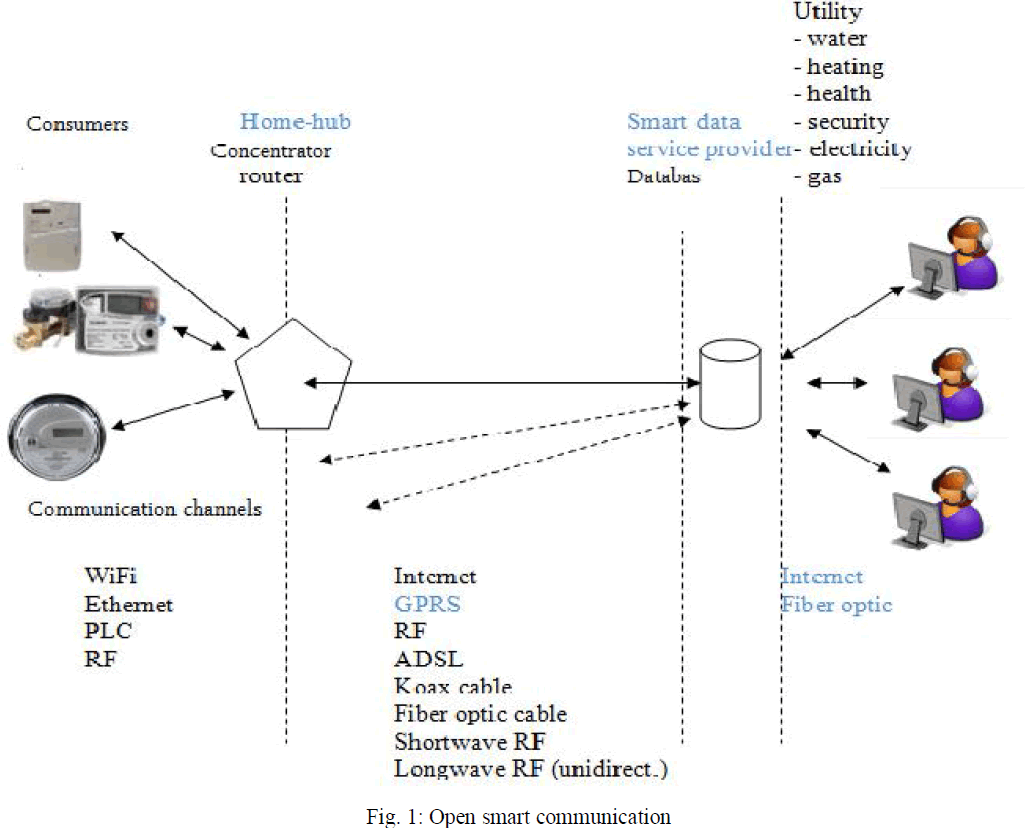 |
III.SMART METER SYSTEM BENEFITS |
| The benefits of Smart Metering installations are numerous for many different stakeholders of the systems. The table below mentions some of the major benefits for utility stakeholders [2]. |
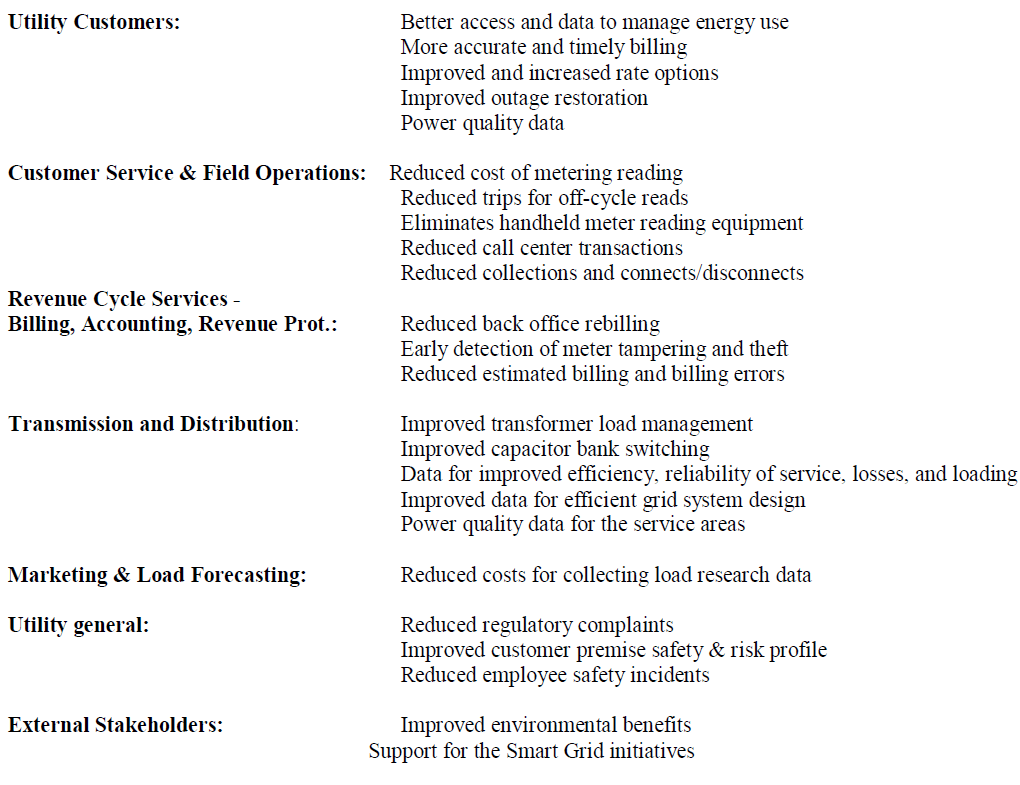 |
IV. THE SMART GRID AND SMART METRING SYSTEM |
| Smart Meter Systems are an integral part of the Smart Grid infrastructure (See figure 2) in data collection and communications. The Smart Grid is essentially the modernization of the transmission and distribution aspects of the electrical grid. Functionally, it is an automated electric power system that monitors and controls grid activities, ensuring the efficient and reliable two-way flow of electricity and information between power plants and consumers— and all points in between. A Smart Grid monitors electricity delivery and tracks power consumption with smart meters that transmit energy usage information to utilities via communication networks [2]. |
| Smart meters also allow the customers to track their own energy use on the Internet and/or with third-party computer programs. The two-way nature of Smart Meter Systems allows for sending commands to operate grid infrastructure devices, such as distribution switches and re-closers, to provide a more reliable energy delivery system. This is known as Distribution Automation (DA) [2]. |
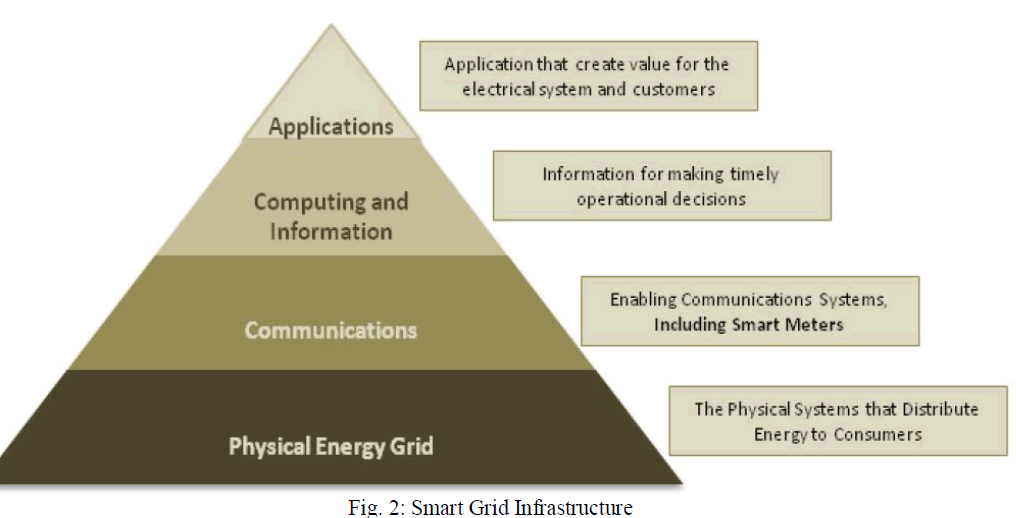 |
| Smart Meter Systems are varied in technology and design but operate through a simple overall process. The Smart Meters collect data locally and transmit via a Local Area Network (LAN) to a data collector. This transmission can occur as often as 15 minutes or as infrequently as daily according to the use of the data. The collector retrieves the data and may or may not carry out any processing of the data. Data is transmitted via a Wide Area Network (WAN) to the utility central collection point for processing and use by business applications. Since the communications path is two - way, signals or commands can be sent directly to the meters, customer premise or distribution device. Figure 3 shows the basic architecture of smart meter system operations [2]. |
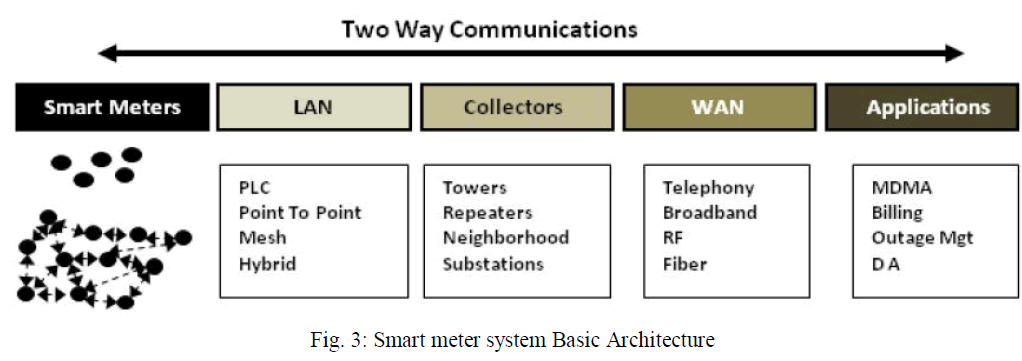 |
V. DEPLOYMENT OF SMART METER SYSTEM |
| The deployment of a Smart Meter System begins with selection of the technology and the planning for installing, operating and maintaining it. Utilities have integrated within the deployment process many elements of management, control and compliance to support successful project implementation [2]. |
| 1. Selection of Smart Meter system |
| There are several steps in the selection process for Smart Meter Projects. These steps are important to the success of the project and for acceptance by the stakeholders [2]. |
| Development of Business, Financial and Technical Requirements: |
| The objectives of developing these documents are very important and set the baseline for future decision making and to make sure that due diligence and compliance focus are included in the process. The objectives are: |
| a) To establish among the utility, project team, and vendor a common understanding of the business requirements that must be satisfied by the Smart Meter System. |
| b) To maintain a common set of expectations among all project stakeholders related to the business requirements that must be satisfied by the system and provide a benchmark for the RFP selection process. |
| Project RFP Bidding Process: |
| After the requirements are developed and approved, the project undergoes a bidding process starting with issuing a Request for Proposal (RFP). The process begins with the formation of a bid team. The team drafts the RFP document, sets time tables, and develops evaluation criteria. The RFP is then sent to qualified Smart Meter system vendors. An initial screening for qualified vendors can be done with assumptions made in the requirements phase. If the RFP is not a turnkey project, a second similar RFP process is used to determine the deployment services vendor. |
| RFP Evaluation: |
| After the RFP’s responses are returned, the bids are evaluated using the criteria determined in the planning. The bids are measured against the business, financial and technical requirements of the utility and then scored. A vendor is selected, approved, and contracts are negotiated. The Smart Meter System Project then transitions to the deployment planning and installation stages. |
| 2. Customer Care and Communications |
| Communications with utility customers concerning the utility’s Smart Meter project begins before the deployment of meters begins. These communications should inform the customer about the new Smart Meter System, the benefits, and how it will affect their energy delivery and billing. |
| 3. Meter and System Certification and acceptance |
| A plan to certify the meters and other system components for purchase and installation is essential to the deployment of the Smart Meter System. The technical requirements developed by the utility will include the Smart Meter equipment specifications for meeting national standards for accuracy, compliance, and functionality criterion. |
| 4. Logistics |
| One of the most important processes in the successful deployment of Smart Meter systems is the logistic and warehousing process. Materials make up 80% of the project capital and management of the processes is a critical success point. The major logistic processes are presented in the table below: |
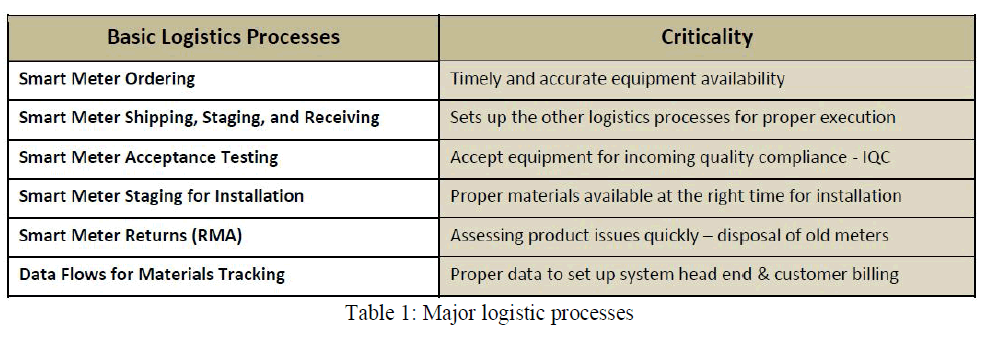 |
| 5. Smart Meter Installation: |
| The planning for the installation of Smart Meters is just as important as the actual installation itself. This part of the process, if done correctly, can lead to smooth installation with a minimum of errors, customer issues or installation delays. The safety aspects of the installation conform to: |
| ïÿýïÿý The National Electric Safety Code (NESC) for utility wiring |
| ïÿýïÿý The National Electric Code (NEC) for home wiring |
| ïÿýïÿý ASNI C12.1 – Code for Electricity Metering |
| ïÿýïÿý Local building codes |
| After the Smart Meter is installed, it is usually ready for operation and is automatically registered with the network system. If the customer is not present and the installation cannot be completed, a notification is left detailing the process to schedule the installation for a later date. |
| 6. Data Management: |
| The Smart Meter installation and billing process must be seamless to the customer to maintain customer satisfaction. Even though there is a short interruption of service to the customer premise, this small outage should be acceptable if the customer is properly notified of the installation and their bill is timely and correct. This requires installing the meter at the proper time of the month and maintaining correct management of the data flow during the Smart Meter process and the legacy billing systems. |
| A software system not part of the utilities’ traditional metering systems but required to operate a Smart Meter System is a Meter Data Management System (MDMS). MDMS is a major component of Smart Meter deployment and operations, and is the least understood and sometimes forgotten component of the project. This software platform receives meter data from one or multiple Smart Meter technologies, verifies and stores the data, and delivers data subsets to the utility operations applications such as billing, outage management, etc [2]. |
VI. REMOTE TRANSMISSION WAYS OF THE CONSUMPTION DATA |
| There are several techniques for remote transmission of the electricity consumption data from the consumers to the utility. The choice of technique is depending on several factors, such as telecommunication network coverage of an area, the number of consumers within the area and if internet is available [4]. |
PLC: |
| Power Line Communication (PLC) is a technique using the already existing and widespread power distribution infrastructure by transmitting data signals through the same power cables that transmit electricity. The idea of using power lines for data communications is not new; the first applications of PLC are dated to over 100 years ago [7], [22]- [23]. PLC can be divided into three different voltage levels; Low Voltage < 1 kV, Medium Voltage 1 kV – 100 kV and High Voltage >100 kV. The communication is also divided into a number of frequency levels which in Europe are decided by the CENELEC Standard EN 50 065-1 and in North America by FCC. |
| There are two variations of PLC; broadband and narrowband and until now narrowband is the one most used for AMR. In Figure 4 an outline of a low voltage PLC communication system can be seen. |
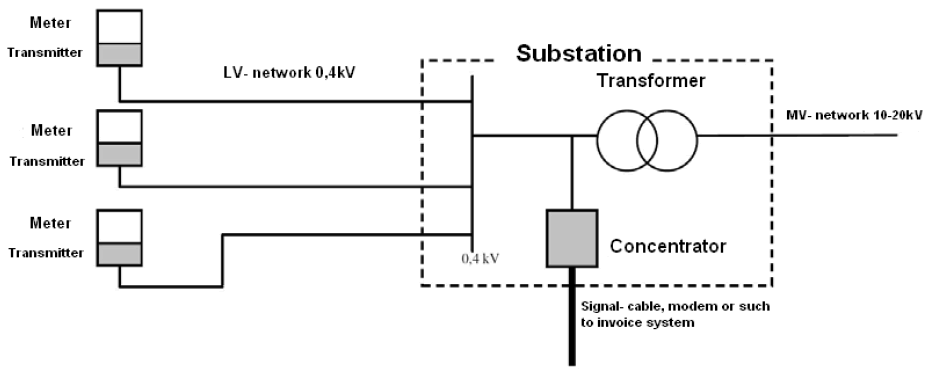 |
2. Turtle: |
| This technique is based on low frequency communication i.e. 5-10 Hz, via the power line and has a reach of 100 km and more. Turtle uses ultra narrow bandwidths and can communicate through the low- and medium- voltage power network. Due to the low frequency the signals can pass through different transformation levels which lower the number of collector stations; they reach large areas and can be placed in distribution stations high up in the network. From the distribution stations existing communication can be used to transmit the data to the utility. |
3. Radio: |
| In the meters which use radio communication a radio sender is installed which sends data to the concentrator/collector. In Sweden the transmission normally takes place over a frequency band of 444 MHz decided by Post & Telestyrelsen (PTS, the Swedish Post and Telecom Agency). This frequency band has been specially conducted for read outs of meters in Sweden. For utilities the advantage with radio is that they own the infrastructure and are independent of other actors and it is easier to plan the costs. There are several suppliers offering meters which communicates via radio, one of them is Kamstrup and is used by some Swedish utilities. The meter is equipped with a small radio sender which sends data to the concentrator. The meter never initiates transmission by itself but answers when data is requested from the central system. The rest of the time the meter is inactive and no data is transmitted. |
| Mesh Technique: A mesh technique is a net structure where the signals themselves find the best way to go through the nodes and the nodes may act as an independent router. The net is also not dependent on electricity to work since the nodes communicate through energy saving and cheap radio senders. Each node acts like a router and since the numbers of neighbors are not fixed, new ones can easily connect and disconnect new nodes. In spontaneous networks this occurs automatically. A mesh network is also self healing i.e. if one node is not working well the signals passes by another node instead. The structure of a mesh network can be seen in Figure 5. |
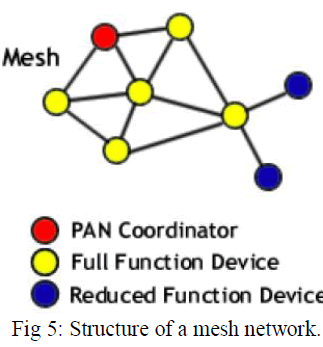 |
| ZigBee: Originally the system was constructed for military use but when the radio technique went cheaper single radio was developed to allow more radios per measure node. ZigBee is a license free technique that operates on the 2.4 GHz band and has a reach of up to 100 meter. It is based on the IEEE 802.15.4 which is an open standard and in addition to automatic meter reading it offers many possibilities; |
| • Home Area Networks (HAN) |
| • HVAC control |
| • Heating control |
| • Home security |
| • Industrial and building automation |
| 4. GSM: Global System for Mobile communications (GSM) is a technology used for transmitting mobile voice and data services. It is a cellular network which means that mobile phones connect to it by searching for cells in the immediate vicinity. |
| 5. GPRS: General pocket radio services is s standard from European Telecommunications Standerd Institute(ETSI) on pocket data in GSM System. GPRS offers an air-interface transer and also allows several users to share the same air-interface resources and enables operators for base charging on the amount of transffered data instead of on-connection time. At the initial time the GPRS uses the same module as GSM. |
VII.SMART METER BASED ENERGY MANAGEMENT SYSTEM |
| The energy management system monitors and/or controls the load, the consumption devices. It informs the user about the tariff, about the energy consuming behavior. The ENERGYHUB is a full smart system that senses, controls and influences the network. EnergyHub handles different timing and programs for switching the lighting, heating, washing. The Web portal gives a lot of hints and advices on how to spare energy. AGILEWAVES was developed by NASA engineers with the Building Optimization System (BOS) method. This web based system cooperates with different sensors, and monitors the HVAC devices (Heating, Ventilation, Air Conditioning) and furthermore the water and irrigations system, gas pipelines, precipitation, humidity, temperature, etc. It supports the renewable resources, such as solar collectors, PV, geothermal heating. GOOGLE POWERMETER cooperates with General Electric or Tendril devices. Open source web based platform ready to accept external development of functions with graphic presentation. This functionality is also available on handheld mobile tools [1]. |
| The practice of energy consumption: The municipial- and public institutions and the people consume without energy consciousness. Energy management belongs to non-technical dept., the proportion of the energy costs is really high. Experiences at a municipality: |
| • The greatest loss is realized at the remote heating |
| • Energy consciousness would be needed |
| • The continuous monitoring would be needed Characteristics of the public institutions: |
| • a lot of different loads (schools, hospital, museum, library, archive, social home for old people) |
| • a lot of sites (a museum has 18 meters) |
| • different tariffs [base load (normal and ripple controlled), public, power dependent, etc. |
| • low voltage level |
| • low consumption (cottage, garage, etc.) |
| • unpredictable and uncontrollable |
| • sites out of operation |
| • particular meters, tenants |
| • lack of specialist |
| • low load factor |
| • absence of utility contracts |
| • liability for public procurement procedure |
| Proposed functionality: The new basic concept of the remote energy management systems is that the public users without specific energy knowledge can handle and monitor the energy consumption of a distributed institution with more sites. It works on the basis of the data collected by smart meters. The information helps the owner to reduce the amount of the used energy, thus to reduce the energy costs [1]. |
| The following functionality is recommended for all types of energy, as gas, water, heat and electricity: |
| • Daily, weekly, monthly amount check and valuation of the consumption (normal, low, extraordinary, etc.) |
| • Daily, weekly, monthly specific values |
| • limit violation alarm |
| • Schedule and trend monitoring |
| • Recommendation for better scheduling |
| • cost forecast |
| • saving potential calculation |
| • Seasonal effects |
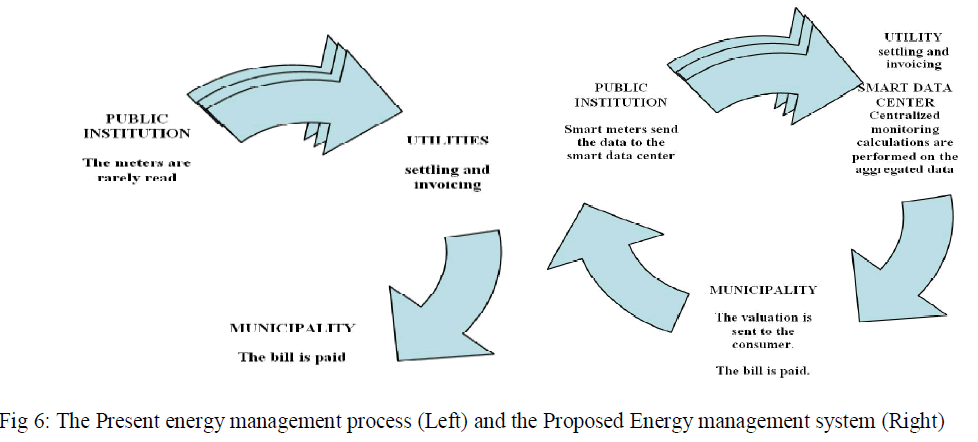 |
X. CONCLUSION |
| The paper presents some smart metering features and state of the art. In this paper we discussed the smart metering system architecture as well as the deployment of the smart metering system. In this paper good level of application possibility has been proposed, which makes these meters useful not only for the utility but also for the consumers and though encouraging the energy saving in economical factor as well. We have also discussed the ways of remote transmission of consumption data. We have presented the case that smart grid and smart metering system is a new frontier of communication research. It poses many unique challenges and opportunity, i.e. Interoperability, /scalability, security, and data management. The success of future smart grid depends on communication infrastructure of the grid, devices and the enabling services. |
| We therefore invisage that smart grid and smart metering would be an existing research area for communication researchers for many years to come. |
References |
|